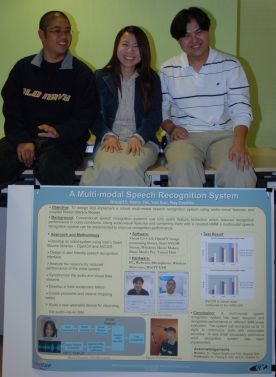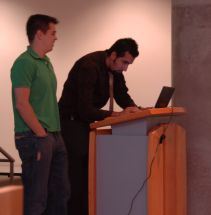Calit2 Sponsors Winning Student Group Project
|
San Diego, CA, April 7, 2006 -- A Calit2-sponsored project on speech recognition won the award for best project for the Electrical and Computer Engineering (ECE) department's winter Engineering Group Design course (ECE 191). Half of the quarter's teams were sponsored or co-sponsored by Calit2.
"Calit2 sponsored six of the 12 projects for the winter quarter, which may be a record," says Bill Hodgkiss, associate director of the UCSD Division of Calit2, who mentored two teams co-sponsored by Calit2 and Scripps Institution of Oceanography. "Working with the ECE 191 students benefits not only the students, but contributes to our research projects as well. The opportunity to explore and assess new, often untried, technologies reveals directions worth further investigation." Hodgkiss is a professor at Scripps and adjunct professor in ECE.
The best-project award for "A Multi-modal Speech Recognition System" was announced after final class presentations and a poster session on March 24. ECE undergraduates Ray Credito, Henry Fei and Yan Sun designed an interface for a speech recognition system using both visual and auditory information to test recognition accuracy under different noise levels. The accuracy for auditory and visual sources combined exceeds that of using only audio. The win was a source of pride for the RESCUE (Responding to Crises and Unexpected Events) project, home of Calit2's speech recognition research work at UCSD.
Mentors for the winning team were Calit2 academic participant and ECE professor Bhaskar Rao, and Rajesh Hegde, a Calit2 postdoctoral researcher in ECE. It was a new project for the course, and first-time mentor Hegde says he "really enjoyed working with the students."
The students' enthusiasm for the project was evident. Ray Credito found the course was "a lot of work, but I had a great time. It was a good learning experience." Henry Fei also enjoyed the course: "In a group project you get more involved and share opinions." Yan Sun agrees: "I love team work." She also noted that mentor Hedge "had a lot of patience and he taught us a great deal."
|
ECE 191 is an upper-division class which is part of the design requirement and is typically taken by seniors. The primary goal of the course is for students to experience engineering design from concept through building, development and testing, as well as to teach the students about working in a group. They work on one aspect of an ongoing project and are not expected to produce a completed product.
Case in point. "Barcode Interpretation from Image Scans of Patient Tags" was one of two projects mentored by Doug Palmer, a Calit2 development engineer. Walid Khelifi and Kevin Randall Hanson developed software which processes images and scans their barcodes. However, they found that due to JPEG image compression, results were often inaccurate. "They did very valuable work, but did not achieve a showy result," explains Palmer. "Ninety-five percent of state-of-the-art engineering never succeeds, because it is risky research and development." The team recommends that future teams explore custom barcode creation and character recognition as possible ways to handle patient identification. Both Khelifi and Hanson enjoyed the work and learned a great deal. Kevin Hanson was happy to "provide a future new direction" for this work. Walid Khelifi is an undergraduate student in Computer Systems Engineering at the University of Bristol in the United Kingdom. He is in the U.S. for a year as part of Bristol's Study Abroad program. He spent last summer interning at Motorola and is at UCSD for the academic year. He enjoyed the project and the hands-on experience. Says Khelifi: "I like seeing the changes we made and am happy we got it working."
"We really appreciate Calit2 researchers Doug Palmer and Paul Blair working with our undergraduates, giving them hands-on experience with open-ended projects," says ECE professor Charles Tu, who is also associate dean of the Jacobs School.
ECE 191 projects are funded or mentored by campus organizations such as Calit2, Scripps Institution of Oceanography and the School of Medicine, and by corporate affiliates of the Jacobs School of Engineering. Raytheon, Echelon, Pacific Alchemy and ViaSat sponsored student projects this winter.
|
Calit2 project scientist Blair mentored a project in conjunction with School of Medicine researchers Gerry Boss and Daniel G. Blanchard. Students Mark Bounlangsy, Frank Diaz, Jason Pang and Hoa Tuong Nguyen worked on "Development of a Miniaturized, Wireless System for Ambulatory Monitoring of Blood Pressure and Cardiac Rhythm." They created a working prototype that detects heart beats and captures the duration between two consecutive beats. This information is then transmitted wirelessly to a cell phone, where the data is analyzed to determine the number of heartbeats per minute (heart rate). By leveraging commodity devices such as cellular smartphones, the intent of this project was to demonstrate affordable mobile cardiac monitoring for the entire population.
ECE 191 was originally given just once a year, but a few years ago when Tu was the chair of the department, it was changed to being taught quarterly. This was because the course proved so valuable. It gives undergraduate students the unique opportunity of working on an open-ended project in a team environment, an experience valuable to their futures whether it is in academia or industry. Professor Pankaj K. Das is the year-round instructor; Tu joins him one quarter per year. The other two quarters per year he is joined by ECE professor Clark Guest.
Speech-recognition team member Sun sums up the experience this way: "We are different people from different fields, with varying perceptions, all enjoying the work. The little thing you work on is important in the whole project."
Related Links



